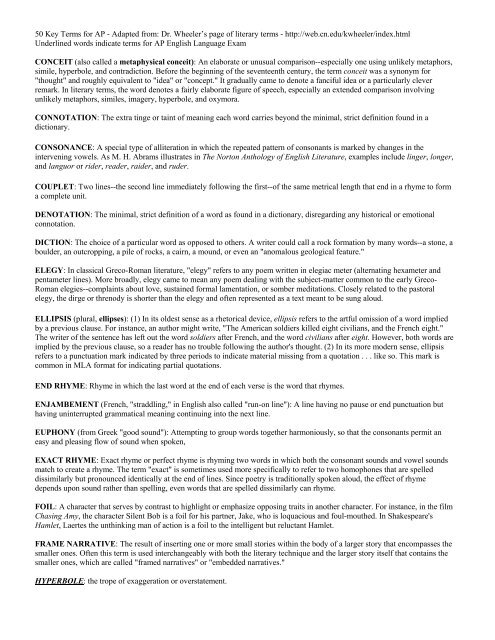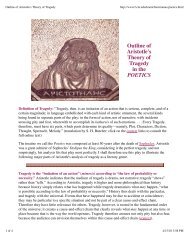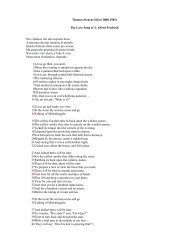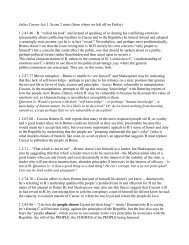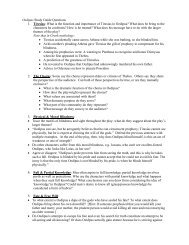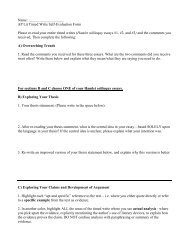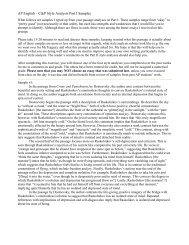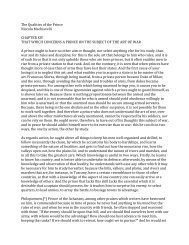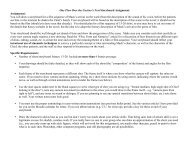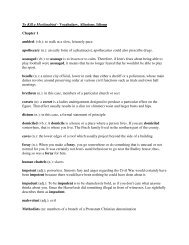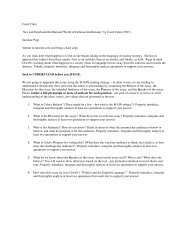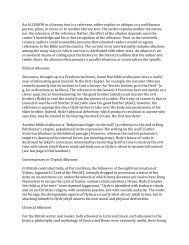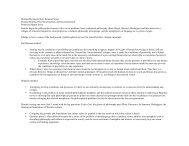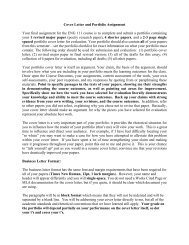50 Key Terms for AP - Adapted from: Dr. Wheeler's page of literary ...
50 Key Terms for AP - Adapted from: Dr. Wheeler's page of literary ...
50 Key Terms for AP - Adapted from: Dr. Wheeler's page of literary ...
You also want an ePaper? Increase the reach of your titles
YUMPU automatically turns print PDFs into web optimized ePapers that Google loves.
<strong>50</strong> <strong>Key</strong> <strong>Terms</strong> <strong>for</strong> <strong>AP</strong> - <strong>Adapted</strong> <strong>from</strong>: <strong>Dr</strong>. Wheeler’s <strong>page</strong> <strong>of</strong> <strong>literary</strong> terms - http://web.cn.edu/kwheeler/index.html<br />
Underlined words indicate terms <strong>for</strong> <strong>AP</strong> English Language Exam<br />
CONCEIT (also called a metaphysical conceit): An elaborate or unusual comparison--especially one using unlikely metaphors,<br />
simile, hyperbole, and contradiction. Be<strong>for</strong>e the beginning <strong>of</strong> the seventeenth century, the term conceit was a synonym <strong>for</strong><br />
"thought" and roughly equivalent to "idea" or "concept." It gradually came to denote a fanciful idea or a particularly clever<br />
remark. In <strong>literary</strong> terms, the word denotes a fairly elaborate figure <strong>of</strong> speech, especially an extended comparison involving<br />
unlikely metaphors, similes, imagery, hyperbole, and oxymora.<br />
CONNOTATION: The extra tinge or taint <strong>of</strong> meaning each word carries beyond the minimal, strict definition found in a<br />
dictionary.<br />
CONSONANCE: A special type <strong>of</strong> alliteration in which the repeated pattern <strong>of</strong> consonants is marked by changes in the<br />
intervening vowels. As M. H. Abrams illustrates in The Norton Anthology <strong>of</strong> English Literature, examples include linger, longer,<br />
and languor or rider, reader, raider, and ruder.<br />
COUPLET: Two lines--the second line immediately following the first--<strong>of</strong> the same metrical length that end in a rhyme to <strong>for</strong>m<br />
a complete unit.<br />
DENOTATION: The minimal, strict definition <strong>of</strong> a word as found in a dictionary, disregarding any historical or emotional<br />
connotation.<br />
DICTION: The choice <strong>of</strong> a particular word as opposed to others. A writer could call a rock <strong>for</strong>mation by many words--a stone, a<br />
boulder, an outcropping, a pile <strong>of</strong> rocks, a cairn, a mound, or even an "anomalous geological feature."<br />
ELEGY: In classical Greco-Roman literature, "elegy" refers to any poem written in elegiac meter (alternating hexameter and<br />
pentameter lines). More broadly, elegy came to mean any poem dealing with the subject-matter common to the early Greco-<br />
Roman elegies--complaints about love, sustained <strong>for</strong>mal lamentation, or somber meditations. Closely related to the pastoral<br />
elegy, the dirge or threnody is shorter than the elegy and <strong>of</strong>ten represented as a text meant to be sung aloud.<br />
ELLIPSIS (plural, ellipses): (1) In its oldest sense as a rhetorical device, ellipsis refers to the artful omission <strong>of</strong> a word implied<br />
by a previous clause. For instance, an author might write, "The American soldiers killed eight civilians, and the French eight."<br />
The writer <strong>of</strong> the sentence has left out the word soldiers after French, and the word civilians after eight. However, both words are<br />
implied by the previous clause, so a reader has no trouble following the author's thought. (2) In its more modern sense, ellipsis<br />
refers to a punctuation mark indicated by three periods to indicate material missing <strong>from</strong> a quotation . . . like so. This mark is<br />
common in MLA <strong>for</strong>mat <strong>for</strong> indicating partial quotations.<br />
END RHYME: Rhyme in which the last word at the end <strong>of</strong> each verse is the word that rhymes.<br />
ENJAMBEMENT (French, "straddling," in English also called "run-on line"): A line having no pause or end punctuation but<br />
having uninterrupted grammatical meaning continuing into the next line.<br />
EUPHONY (<strong>from</strong> Greek "good sound"): Attempting to group words together harmoniously, so that the consonants permit an<br />
easy and pleasing flow <strong>of</strong> sound when spoken,<br />
EXACT RHYME: Exact rhyme or perfect rhyme is rhyming two words in which both the consonant sounds and vowel sounds<br />
match to create a rhyme. The term "exact" is sometimes used more specifically to refer to two homophones that are spelled<br />
dissimilarly but pronounced identically at the end <strong>of</strong> lines. Since poetry is traditionally spoken aloud, the effect <strong>of</strong> rhyme<br />
depends upon sound rather than spelling, even words that are spelled dissimilarly can rhyme.<br />
FOIL: A character that serves by contrast to highlight or emphasize opposing traits in another character. For instance, in the film<br />
Chasing Amy, the character Silent Bob is a foil <strong>for</strong> his partner, Jake, who is loquacious and foul-mouthed. In Shakespeare's<br />
Hamlet, Laertes the unthinking man <strong>of</strong> action is a foil to the intelligent but reluctant Hamlet.<br />
FRAME NARRATIVE: The result <strong>of</strong> inserting one or more small stories within the body <strong>of</strong> a larger story that encompasses the<br />
smaller ones. Often this term is used interchangeably with both the <strong>literary</strong> technique and the larger story itself that contains the<br />
smaller ones, which are called "framed narratives" or "embedded narratives."<br />
HYPERBOLE: the trope <strong>of</strong> exaggeration or overstatement.


